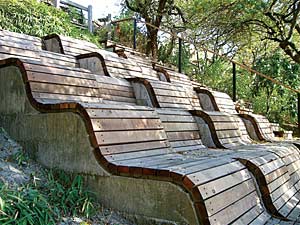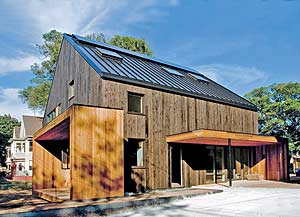Design-build educators talk pedagogy and real politick.
AR: Adam, Andrew, and Dan, you’ve all inherited your programs. How have you dealt with that legacy, or shaped these studios in your image?
Hopfner: This is my second year directing the Yale Building Project. I take the stance very strongly that I do not have authorship. I think there’s a danger in that, and I’m certainly not teaching to get my aesthetic agenda across.


constructed a house for a disabled female veteran and her family, which also includes a one-bedroom rental unit (above).
I have tried to make housing issues a little more current and to that end we’ve been working with an organization called Common Ground, a nonprofit to end homelessness, as of last year. We found that veterans make up 28 percent of all homeless, and that people are coming home from these conflicts with huge emotional disorders. We’ve identified female veterans as the group in need of housing. We did a lot of research into the psychology and brought these social issues to the fore to see how that would affect the design position. The second thing I’ve tried to do is make more explicit the process as opposed to the product—the constraints of the site, zoning, budget, time, and environment that really come to bear on a project.
Lewis: One thing that I think is really critical is, even though it’s design-build by students, the design absolutely has to be of the highest mark of excellence. The students have more time than an architecture firm can give to this project, so the results should exceed what professionals should be able to do. Instead of just learning how to work materials, this is an opportunity you won’t have when you go out into the profession. It’s something I’ve inherited and I think it’s critical to maintain that position, especially with the client.
Dutton: Sometimes, because of skills they don’t have, you have to prevent students from falling into banality. At the same time students are captivated by what’s going on in the media. That’s an interesting tension: Sometimes you have to pump them up and make them go beyond what they think they can do so it’s creative and has a deep expression, and sometimes you have to prevent them from parroting magazines.
Freear: From my point of view, when Mockbee dropped dead it was simply a case of keeping up. It never has been a deliberate ‘I’ve got to establish my own style.’ I hope what I have tried to do is protect the luxury of time: The Rural Studio has a huge luxury of time over a lot of these other programs. Fifth-year students, for example, are here technically for nine months, though they stay upwards of a year afterward to finish their projects on their own time and dollar. I get a lot of grief from the university for allowing that to happen. But it’s about raising the standards, the craft, the level of detail and the quality—it’s about being more rigorous. I don’t really apologize for any of it. There are few places where you do something because you want to do it and you want to do it right. I’m trying to be fiercely protective of that opportunity, and to have students understand how long it takes and how difficult it is to do something well.
Dutton: I have a question for everyone. When we were doing this stuff before the residency began in 2006 we would work on a housing unit over a year and a half. Talk about inheritance: One group gets started, and the next group has all kinds of critique. They want to move the kitchen to this location or that location. A lot of effort is spent in passing the baton and finding your own value in it.
Rockhill: I admire your ability to do that. I could never do that. I don’t know how you have that sense of ownership as a project gets handed down, month after month or quarter after quarter. We start full-time in January and have a finished product in the third week of May.
Louis: In Mexico we handed down the projects. We tried to make every piece a distinct opportunity for an individual design. Now we have a start and a finish.
In terms of personal vision, I think you lose credibility if you have a design agenda. If students do come up with an idea, they have so little experience in detailing that they’ll appreciate your input. They tend to design too much, they tend to make every single detail into something crazy. That’s what Sambo used to say, “Pick your heavy hits.” Some stuff has to be simple and background.
Rockhill: The prefabrication for Greensburg minimized design arguments, because suddenly widths had to be this and so forth. The constraints gave some discipline to the project. I found it to be a blessing.
Hopfner: This year I gave students the footprint of the building. Last year there were 19 corners in the house, this year there were four. And the project is architecturally so much stronger as result. The setbacks effectively dictated the footprint of the building. But there are 60 students who want authorship, so when you say, Okay Bob and Joe, you guys have to develop the stairwell, it becomes this utterly solipsistic exercise. I spend a lot of time trying to wrestle these things into a coherent language.
Louis: Working with the Navajos, we hear lectures on the creation story and we want to be very attentive to those concerns in general, so that obviously helps define the design aspirations. We’re trying to have the Navajos help work on the house. I intend to show them how to put together the earthen components.
